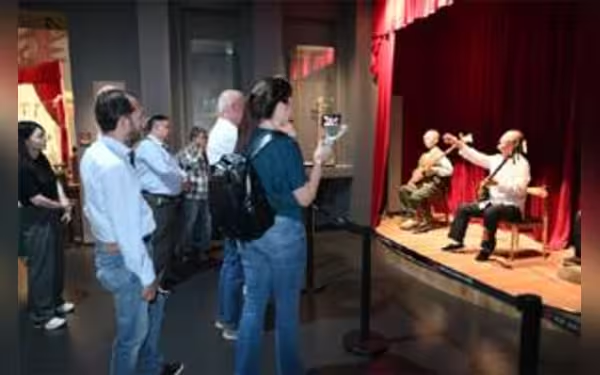Saturday, November 16, 2024 09:33 PM
Pakistani Delegate Explores Cultural Heritage in Shaanxi, China
- Cultural exchange between Pakistan and China through music.
- Naveed Hussain connects Sanxian and sitar instruments.
- Ancient Shimao ruins highlight heritage preservation importance.
 Image Credits: nation_pk
Image Credits: nation_pkA Pakistani delegate visits Shaanxi, China, exploring cultural heritage and music, highlighting connections between Sanxian and sitar instruments.
In a remarkable cultural exchange, a Pakistani delegate recently visited the Northern Shaanxi Folk Song Museum in China, where he experienced the enchanting sounds of the three-stringed music instrument known as the Sanxian. This visit highlights the rich tapestry of cultural heritage that exists between Pakistan and China, showcasing how music can bridge gaps and foster understanding among diverse civilizations.
The performance at the museum was a blend of passion and melody, captivating the audience with its unique charm. As the musicians played, the atmosphere was filled with storytelling, echoing the deep-rooted traditions of the region. The delegate, Naveed Hussain, noted the similarities between the Sanxian and Pakistan's own three-stringed instrument, the sitar. He explained, "In Pakistan, we have a three-stringed instrument known as the sitar. It is a long-necked lute commonly played in the northern regions. Often performed in tea rooms, it can accompany singing, sometimes alongside drums." This connection illustrates how music transcends borders, creating a universal language that resonates with people from different backgrounds.
During his visit, Naveed explored the Intangible Cultural Heritage Exhibition Hall in Yuyang District, Yulin City, Shaanxi Province. The exhibition featured 15 different rooms showcasing various forms of traditional art, including stone carving, clay sculpture, paper cutting, and embroidery. A memorable moment occurred when a paper-cutting artist crafted a rabbit figure for Naveed, who was born under the Chinese zodiac sign of the rabbit. He expressed his delight, stating that he would take this piece of art back to Pakistan to share with his family, further emphasizing the importance of cultural exchange.
As Naveed toured the Shimao ruins in Shenmu City, he marveled at the ancient civilization that once thrived there. These ruins, dating back approximately 4,300 years, reveal a sophisticated society with impressive fortifications and infrastructure. Naveed drew parallels between these ruins and other ancient civilizations, such as those in Egypt and Latin America, highlighting the significance of preserving such heritage. He remarked, "The ruins are a successful example of heritage discovery and protection, ensuring that this valuable cultural heritage can be preserved for future generations."
This visit not only allowed Naveed to appreciate the cultural richness of China but also opened avenues for collaboration in heritage preservation. He expressed hope that with advanced excavation technologies, China could assist Pakistan in uncovering more of its own historical treasures. This sentiment underscores the potential for mutual growth and understanding through shared cultural experiences.
The visit to the Northern Shaanxi Folk Song Museum serves as a reminder of the power of cultural exchange. It highlights how music and art can connect people across borders, fostering respect and understanding among diverse civilizations. As we continue to explore our shared heritage, it is essential to recognize the value of preserving these traditions for future generations, ensuring that the stories of our past remain alive and vibrant.













